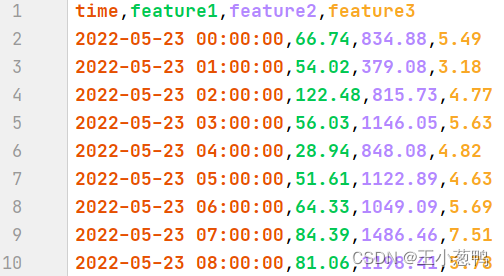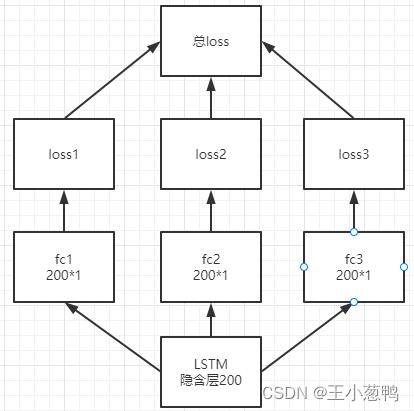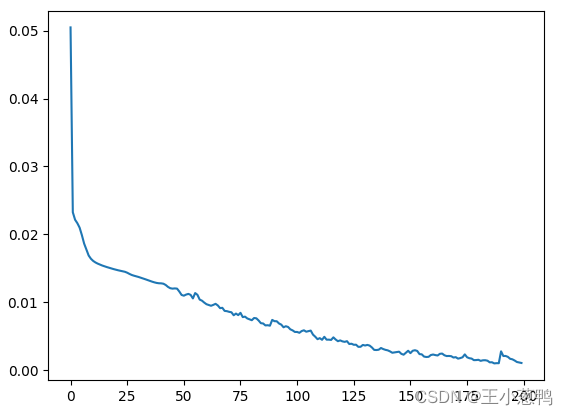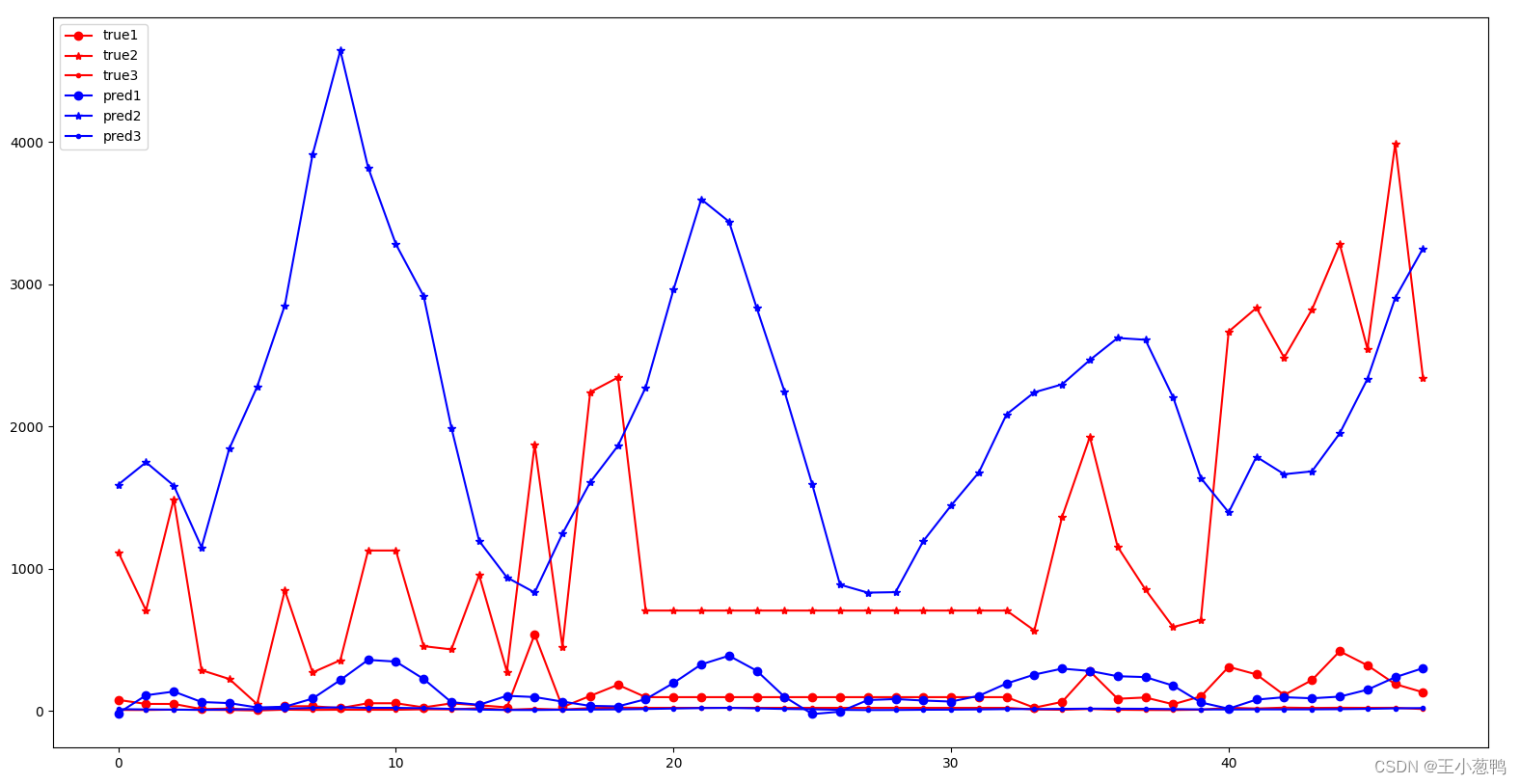问题描述
使用LSTM做负荷预测问题,数据共计456行,每一行3个特征,用过去N个时间段特征,预测未来第N+1个时间点的特征,数据格式如下,用00:00:00-04:00:00的[feature1,feature2,feature3],预测第05:00:00的[feature1,feature2,feature3]。本问题属于多变量预测,输入是多变量-多时间步,输出也是多变量,只不过输出是一个时间点,可以使用循环的方式预测多个时间步。

模块导入
import pandas as pd
import matplotlib.pyplot as plt
import torch.nn as nn
import torch
import time
import numpy as np
import random
2 数据处理
2.1 数据导入以及可视化
data = pd.read_csv("负荷-3变量.csv")
data.plot()
plt.show()

2.2 划分测试集和训练集
data = data.iloc[:, [1, 2, 3]].values # 获取数值 456 *3
p = 48 # 预测未来48个小时的数据
train_data = data[:-p]
test_data = data[-p:]
- train_data 维度:408*3
- test_data 维度:48*3
2.3 数据归一化
每一列都需要单独归一化,所以axis的值为0
min_data = np.min(train_data, axis=0)
max_data = np.max(train_data, axis=0)
train_data_scaler = (train_data - min_data) / (max_data - min_data)
2.4 将一个序列划分为x和y
制作数据集,对应的x和y,假设用前12个时间步预测第13个时间点,则:
- x 维度:12 *3
- y 维度:1 *3
假设用前24个时间步预测第25个时间点,则: - x 维度:24 *3
- y 维度:1 *3
def get_x_y(data, step=12):
# x : 12*3
# y: 1 *3
x_y = []
for i in range(len(data) - step):
x = data[i:i + step, :]
y = np.expand_dims(data[i + step, :], 0)
x_y.append([x, y])
return x_y
2.5 生成mini_batch数据
假设batch_size = 16, 则生成的数据维度为:
- x:16* 12 * 3
- y: 16 * 1 * 3
def get_mini_batch(data, batch_size=16):
# x: 16 * 12 *3
# y :16 * 1 *3
for i in range(0, len(data) - batch_size, batch_size):
samples = data[i:i + batch_size]
x, y = [], []
for sample in samples:
x.append(sample[0])
y.append(sample[1])
yield np.asarray(x), np.asarray(y)
3 模型搭建和训练
3.1 搭建模型
在处理多变量预测时,我们将lstm输出分别连接3个fc层,每个变量都单独计算loss,再把loss进行相加作为总的loss,示意图如下所示:

device = torch.device("cuda:0" if torch.cuda.is_available() else "cpu")
class LSTM(nn.Module): # 注意Module首字母需要大写
def __init__(self, hidden_size, num_layers, output_size, batch_size):
super().__init__()
self.hidden_size = hidden_size # 隐含层神经元数目 100
self.num_layers = num_layers # 层数 通常设置为2
self.output_size = output_size # 48 一次预测下48个时间步
self.num_directions = 1
self.input_size = 3
self.batch_size = batch_size
# 初始化隐藏层数据
self.hidden_cell = (
torch.randn(self.num_directions * self.num_layers, self.batch_size, self.hidden_size).to(device),
torch.randn(self.num_directions * self.num_layers, self.batch_size, self.hidden_size).to(device))
self.lstm = nn.LSTM(self.input_size, self.hidden_size, self.num_layers, batch_first=True).to(device)
self.fc1 = nn.Linear(self.hidden_size, self.output_size).to(device)
self.fc2 = nn.Linear(self.hidden_size, self.output_size).to(device)
self.fc3 = nn.Linear(self.hidden_size, self.output_size).to(device)
def forward(self, input):
output, _ = self.lstm(torch.FloatTensor(input).to(device), self.hidden_cell)
pred1, pred2, pred3 = self.fc1(output), self.fc2(output), self.fc3(output)
pred1, pred2, pred3 = pred1[:, -1, :], pred2[:, -1, :], pred3[:, -1, :]
pred = torch.stack([pred1, pred2, pred3], dim=2)
return pred
3.2 训练模型
epochs = 200
for i in range(epochs):
start = time.time()
for seq_batch, label_batch in get_mini_batch(train_x_y, batch_size):
optimizer.zero_grad()
y_pred = model(seq_batch)
loss = 0
for j in range(3):
loss += loss_function(y_pred[:,:, j], torch.FloatTensor(label_batch[:, :, j]).to(device))
loss /= 3
loss.backward() # 调用loss.backward()自动生成梯度,
optimizer.step() # 使用optimizer.step()执行优化器,把梯度传播回每个网络
# 查看模型训练的结果
print(f'epoch:{i:3} loss:{loss.item():10.8f} time:{time.time() - start:6}')
3.3 预测模型
model.eval()
with torch.no_grad():
model.hidden_cell = (torch.zeros(1 * num_layers, 1, hidden_size).to(device),
torch.zeros(1 * num_layers, 1, hidden_size).to(device))
# 测试集
total_test_loss = 0
test_pred = np.zeros(shape=(p, 3))
for i in range(len(test_data)):
x = train_data_scaler[-time_step:, :]
x1 = np.expand_dims(x, 0)
test_y_pred_scalar = np.expand_dims(model(x1).cpu().squeeze().numpy(), 0) # 预测的值0-1
train_data_scaler = np.append(train_data_scaler, test_y_pred_scalar, axis=0)
y = test_y_pred_scalar * (max_data - min_data) + min_data
test_pred[i,:] = y
x_in = list(range(len(test_pred)))
3.4 结果可视化
loss图像

最后3个变量的预测结果,看出能预测大体趋势,但是数据集质量不高,导致最后的结果不好,模型也需要继续优化。

完整代码和数据集,关注公众号:AI学习部 ,发送“时间序列”关键词获取,或联系Q 596520206。























 399
399











 被折叠的 条评论
为什么被折叠?
被折叠的 条评论
为什么被折叠?










